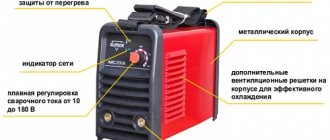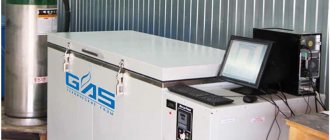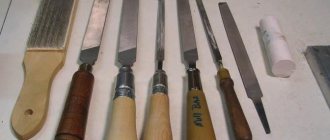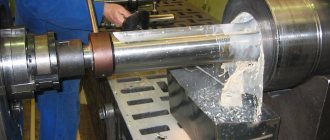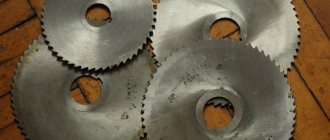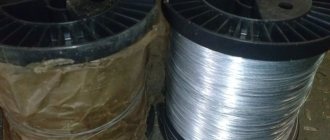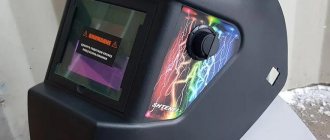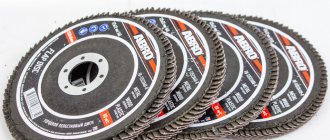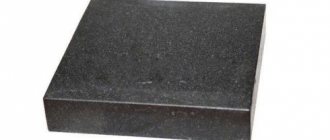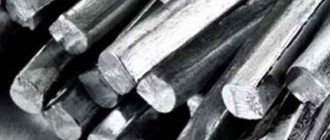All home craftsmen who have a lathe in their garage or workshop invariably face the problem of soldering cutters with their own hands. Of course, someone can solve this issue at an enterprise where he or one of his friends works, but in this case a dependency arises, that is, the turner will not be able to do such work at any time. When you need to solve such issues immediately, no matter how skilled a turner you are, you will have to do without specialized equipment that is available at the same factory or depot, but this is possible.
Brazing of carbide inserts
An important condition for soldering is that the solder, to melt which a gas burner is used, must melt at a lower temperature than the material of the parts itself Source rem-serv.com
Such a process as soldering carbide plates onto a cutter holder is very responsible, since any , even a minor defect in this process can be critical when processing a metal workpiece. For example, if the plate is soldered unevenly or there is a gap between it and the holder head, the soldering will simply break off when turning or cutting the part. To avoid such emergency situations, it is important to adhere to certain rules and recommendations, which will be discussed below.
What types of solders are there?
The solder used when soldering cutters must have a melting point that is at least 300°C higher than the temperature that occurs when turning or cutting the metal being processed. In addition, it must remove heat from the soldering to the holder - this function stabilizes the processing of parts. The table below shows the recommended solders according to GOST 5688-61.
| Name | Chemical composition | t°C | Application area |
| Copper-nickel or cupronickel | Cu – 68.7%; Ni – 27.5%; Al – 0.8%; Zn – 3.0% | 1170 | Maximum mechanical loads when heating the cutting part to 900°C |
| Electrolytic copper | Cu – 99.9%; impurities – 0.1% | 1083 | Increased mechanical loads when the cutting part is heated to 700°C |
| Brass-nickel | Cu – 68.0%; Zn – 27%; Ni – 5.0% | 1000 | Increased mechanical loads when the cutting part is heated to 700°C |
| Brass L-52 | Cu – 62.0%; Zn – 38.0% | 900 | Average mechanical loads when the cutting part is heated to 600°C |
| Silver PSR-45 | Ag – 10%; Cu – 53%; Zn – 37% | 720 | For high-titanium alloys grades T60K6 and T30K4 |
DIY induction soldering of cutters
Many people are attracted to electric heating because it works autonomously and does not require constant supervision. The negative side of such heating boilers is the cost and technical requirements.
In some places they simply cannot be used. But many owners are not afraid of this, and they believe that it is the ease of operation that covers all the shortcomings.
Especially when new types of electric boilers with inductive coils, rather than heating elements, appeared on the sales markets. They heat up the coolant with instant speed and economically heat the building, according to the owners of the units. The new type of boiler is called induction.
The new type of heaters is easy to use. They are considered safe, in comparison with gas heaters, there is no soot and soot, which cannot be said about devices with solid fuel. And the most important advantage is that there is no need to prepare solid fuel (coal, firewood, pellets).
And as soon as induction heaters appeared, there were immediately craftsmen who, in order to save money, were trying to create such an installation with their own hands.
In this article we will help you design a heating device yourself.
A device where metal and similar products are heated without contact is called an induction heater. The operation is controlled by an alternating induction field acting on the metal, and the currents inside generate heat.
High frequency currents affect the product in addition to insulation, which is why the design is unusual compared to other types of heating.
Today's induction heaters contain semiconductor frequency reducers. This type of heating is widely used in the heat treatment of surfaces made of steel and various compounds and alloys.
The compactness of equipment is used in innovative technologies, while there is a huge economic effect. A variety of models help implement flexible and automated combinations, including all-round transistor frequency reducers and connection blocks when an induction system is preferred.
Description
A typical heating element includes the following components:
- A heating element in the form of a rod or metal tube.
- An inductor is a copper wire that frames a coil in turns. During operation, it acts as a generator.
- Alternator. A separate design where standard current is converted into a high frequency value.
In practice, induction units have been used recently. Theoretical studies are much ahead. This can be explained by one obstacle - obtaining high frequency magnetic fields. The fact is that using low-frequency settings is considered ineffective. As soon as high-frequency current generators appeared, the problem was solved.
HDTV generators have passed their evolutionary period; from lamp ones to modern models based on IGBT. Now they are more efficient, lighter in weight and smaller in size. Their frequency limitation is 100 kHz due to dynamic losses of transistors.
Operating principle and scope
The generator increases the frequency of the current and transfers its energy to the coil. The inductor converts high-frequency current into an alternating electromagnetic field. Electromagnetic waves change at high frequencies.
Heating occurs due to the heating of eddy currents, which are provoked by alternating eddy vectors of the electromagnetic field. Energy is transmitted with almost no losses with high efficiency and enough energy to heat the coolant and even more.
The battery energy is transferred to the coolant, which is located inside the pipe. The coolant, in turn, is the coolant of the heating element. Due to this, the service life increases.
Industry is the most active consumer of induction heaters, since many designs involve high heat treatment. Their use increases the strength of the product.
Methods for brazing carbide inserts
Soldering of carbide plates is carried out in flame, gas or electric muffle furnaces Source youtube.com
Soldering of cutters consists of heating the plate itself and melting the solder, which can be done in different ways using:
- High frequency currents.
- Plasma gas or muffle furnaces.
- Contact welding.
- Oxy-acetylene torch.
Recommendation: for silver solders, high-titanium alloys T60K6 or T30K4 should be used, which reduce the thermal stress that appears during cooling.
Saw blade for wood with carbide tips
The discs are designed for sawing wooden products from the most common wood species. Included in the package of circular saws. The maximum permissible rotation speed is about ten thousand revolutions per minute. They are made from molybdenum high-carbon steel with additions of chromium, nickel, and pobedite, which serve to extend service life. Protects against thermal deformation. Carbide-tipped teeth contain cobalt and tungsten compounds. This makes it possible to increase their wear resistance, sharpen cutting edges and increase resistance to impact loads.
Video description
Soldering a turning tool.
In flame, gas or muffle furnaces
First of all, the holder head is heated in an oven to a temperature of 800°C, at which the borax melts (Na₂[B₄O₅(OH)₄]·8H₂O). Then powdered or paste-like borax is poured onto the seat and sent back to the oven. The newly heated part is taken out of the furnace and, using a metal brush, the slag is removed from the place where the cutter fits. After cleaning, the seat is again sprinkled or smeared with flux, a carbide plate is placed there, it and the seat base are thickly sprinkled with brown, solder is placed on top and again sent to the oven, heated to 1200°C until the solder melts.
After the solder has melted, the cutter is removed from the oven, placed on some flat metal surface and, if necessary, the carbide plastic is adjusted. Then the plate is pressed tightly to the seat (you can use a minus screwdriver) and wait 5-6 seconds until the solder sets. But all this needs to be done very quickly, before the part has cooled down.
To avoid cracking of the solder from thermal stress during cooling, the finished cutter is immersed in a box with heated sand or ground charcoal. Of course, if you have a chamber oven at home, then heat it to 250°C, place the cutter there and leave it until it cools completely along with the oven. After all the procedures, the cutter is cleaned in the factory with a sandblaster, but at home you can do this with a metal brush.
Features of the solder used
The carbide plate soldered during processing takes the main load. That is why special attention is paid to solder. The melting point of the material used should be 300 degrees Celsius higher than the expected heating temperature of the tool during machining of the workpiece. In addition, the following criteria apply to solder:
- High strength and elasticity. These qualities must be maintained when the temperature increases during processing of the workpiece.
- Good fluidity ensures reliable connection of the plate to the base. In the production of cutters and milling cutters, attention is paid to the fact that the alloy must be evenly distributed over the entire base area.
- Increased thermal conductivity. In order for the soldering to last a long time, it should not heat up during operation. The alloy used removes some of the heat, thereby increasing the service life of the cutting edge.
After wear of the carbide plates, it is possible to replace them. Due to this, the main part of the tool can be reused if there are no defects.
Solders and fluxes
For high-quality bonding, you need to be smart about the choice of flux and solder. This matters when the work is performed either with a gas torch or a soldering iron. Experienced craftsmen argue that it is necessary to use a more active solder, which contains zinc chloride. It is he who is able to clean the surface of objects from the appearing films of zinc oxide during heating.
Therefore, it is better to purchase a special flux, which can be borax. If you have to work with an alloy containing a large amount of copper, then it is better to use silver or copper-phosphorus components.
When the objects being joined differ in the material of manufacture, it is especially important to know which solder is suitable. Solder for soldering brass must be compatible with the surfaces of the products and have a temperature significantly lower. If there are no strict requirements for strength and appearance, the connection is possible with tin.
Installation of HDTV induction soldering
Induction soldering units
An induction installation is an installation for induction heating of metal parts. It consists of a generator and an induction coil - an inductor. It is with the help of an inductor that the magnetic field is transmitted to the heated part. The power elements of the generator and the induction coil, made of a copper tube, are cooled with water.
Induction heating technology is energy saving, since all energy is spent only on heating the part.
Induction heating using HDTV units is realized using the energy of an alternating magnetic field. The workpiece is placed inside the inductor loop of the required size. The high-frequency alternating current passing through this loop induces eddy currents on the surface of the part, the magnitude of which is controlled by the installation. The use of a HDTV installation is characterized by high energy transfer efficiency and low heat losses. The depth of penetration of induced currents directly depends on the operating frequency of the HDTV induction heating installation. The higher the frequency, the greater the relative current density on the surface of the workpiece. By lowering the operating frequency at the HDTV installation, it is possible to increase the depth of current penetration.
The abbreviation HDF stands for high frequency currents. High-frequency equipment (high-frequency installations) are used for high-frequency hardening and high-frequency heat treatment of metals. On older models of HDTV generators were tube generators, then thyristor frequency converters (TFCs) began to be used. Recently, thyristor induction units have gained the most popularity due to their increased efficiency, smaller size, and longer service life than lamp induction units. Each induction installation must have a water cooling system. The more energy is released in the form of induction heating, the less power is required for the cooling systems of the power elements of the HDTV installation itself.
Modern induction heating installations are equipped with microprocessors that control the current supply process, as well as displays that show heating characteristics and parameters, and they are also assembled on
Induction heating unit GP-60E (60 kW)
transistor modules (IGBT type) and field-effect transistors (MOSFET type). The new element base made it possible to increase the efficiency of installations to 96%.
Induction heating installations are designed for heating parts (simultaneous or sequential) for hardening to a depth of up to 10 mm, as well as the widespread use of other types of induction heating for heat treatment of cast iron or steel parts of various shapes. Such as forging, shrink-fitting, joining or welding, drying of painted surfaces, etc.
The most important characteristic of an induction heater is the power of the installation. The higher the heater power, the faster the induction heating of the part occurs and the larger the part the installation can heat.
Types of induction installations:
1) Mid-frequency induction units. The induction unit received this name due to the low frequencies at which it operates. The frequency of such installations is 0.5-20 kHz. Such induction installations are used when it is necessary to heat a part to the maximum possible depth. Typically used for metal melting, stamping and hardening. The penetration depth of the mid-frequency induction unit can reach up to 10mm.
2) High-frequency induction installations. The frequency of these induction installations is 20-40 or 30-100 kHz.
The penetration depth of the high-frequency induction unit is 2-3mm. But it is also possible to increase the depth if the heating time is increased.
3) Microwave induction installations. The penetration depth of the induction field is 1 mm. Ultrahigh-frequency units are used for surface hardening.
The induction heater has automatic protection and turns off the load in case of any operator errors or adverse external factors.
9 reasons for shutdown:
- absence or phase imbalance
— lack or high temperature of coolant
-absence of workpiece in the inductor for more than 2 seconds
- low frequency on the inductor
High frequency generator for installation GP-60E (60kW)
The high-frequency installation automatically adjusts the inverting frequency to any inductor.
The transformer parameters and compensating capacitance in the installation are not adjustable. With repeated removal and installation of the inductor, the inductance of the circuit does not change (no more than 1% on an inductor with a small number of turns); therefore, it is possible to use an unlimited number of inductors. The inductor replacement time is 5 minutes, the inductor material is a copper tube of 8-12 mm and a wall thickness of 1 mm.
High frequency induction units
How to solder cutters yourself?
In order to perform soldering, you must follow the following steps:
- First of all, it is necessary to clean all metal elements. The oxide film is removed.
- The cutter holder is installed on the transformer busbars. The area that will be solderable must be pre-treated with flux. After this, the solder begins to work.
- Using tweezers, solder is inserted between the edges that require joining. In a particular case, it is better to use a sheet of brass for this purpose.
- During operation of the unit, the contact area will heat up. This contributes to the melting of the metal, and as soon as this process is completed, the contact will disintegrate, and, accordingly, the process will stop. Therefore, in order for soldering to be continuous, all work is carried out in pulse mode, while the load on the windings must be applied gradually.
The heating itself is carried out over the entire surface, moving smoothly from side to side. The solder should acquire a color from dark cherry to light cherry, which will indicate heating to the required temperature.
While visually monitoring the entire process, it is necessary to carefully apply all the solder. You should know that the holder heats up at a rate of 80-100 degrees per second. Using this method for connecting cutters, you can be sure of obtaining excellent quality.
If the flux has been applied in sufficient quantity, the solder will spread easily. After completion of the work, the seams are cleaned.
It is believed that a high-grade connection is one that does not exceed 0.1 mm. As is clear, there is nothing complicated in home soldering. The main thing is to have all the necessary tools and materials at hand. But you need to remember that during the entire process you should follow personal safety rules, since high temperatures can harm the solder.
Workplace for soldering cutters 15 kW.
Special Price Find out the price
- Description
- Specifications
- Documentation
Set contents:
| 1. Frequency converter IF 15-8-50/WS-0.6-2 | 1 PC. |
| 2. Water cooling station SVO-2.5S | 1 PC. |
| 3. Inductor | 4 things. |
| 4. Power cable for IHM 30 | 1 PC. |
| 5. Pedal | 1 PC. |
| 6. Current lead 1.2 kA | 1 PC. |
| 7. Packaging | 1 PC. |
| 8.Operation manual | 1 PC. |
| 9. Passport | 1 PC. |
| Maximum power consumption | 730 W |
| Supply voltage | 380/220V +10/-15% V |
| Weight with empty tank | 72 kg |
| Weight with filled tank | 122 kg |
| Heating time up to 1200°C | D16 length 50 mm, no more than 18 sec D22 length 100 mm, no more than 40 sec D32 length 100 mm, no more than 80 sec |
| Volume of the tank | 60 l |
| Pump power | 370 W |
| Electric fan power | 34 W |
| dimensions | 1120x810x1300 mm |
Areas of use
The possibility of soldering with brass ensures a reliable connection of metal products, which determines the limits of application of this technology.
It would be impossible to do without this method of joining parts when producing products in such industries as:
- electronic manufacturing;
- assembly of refrigeration and heat exchange equipment (in this case, brass solder is used when soldering thin copper tubes);
- production of special cutting tools (cutters and attachments for them).
In the electronics industry, brass solders can be used to solder components of complex circuits and connect them to metal conductors.
In addition, brass solders are widely used when it is necessary to join metal workpieces of different thicknesses, as well as when carrying out tinning operations, which ensure the creation of a reliable protective coating on the metal surface.
Features of copper soldering
When soldering copper tubes, you can use both regular copper-phosphorus solder and those containing silver. The result is approximately the same, the quality of the seam is good.
Before starting soldering, the surface of the copper will need to be well heated with a gas burner, and only then apply solder. Otherwise, the quality of the seam may be unsatisfactory.
Some differences between these two solders can be noticed directly during the soldering process. For example, ordinary copper-phosphorus solder flows better, but solder with silver is no longer as flowable.
Brazing
The use of hard solders occupies an intermediate position between low-temperature soldering and welding.
Hard soldering diagram.
They are used in cases where the strength of the resulting joints and the integrity of the metal structure become important. In this process, carbide plates are often used, which, when connected, do not spoil the original geometry of the structure.
This technology is used for repairing refrigeration or heat exchange systems, steel or copper pipelines, etc. It is also used in automotive repair to repair radiators, engines, transmissions, bodies and other similar parts.
If there is a need to repair products that are susceptible to high temperatures during operation (for example, a wood-burning samovar), then high-temperature soldering is simply necessary.
As for the equipment, in this case, a technique is required that is capable of providing a temperature higher than that required for melting the parts being connected. The average range can vary from 450 to 1200 degrees, provided that the entire procedure is performed at home. Gas burners, inductors and furnaces have such indicators.
